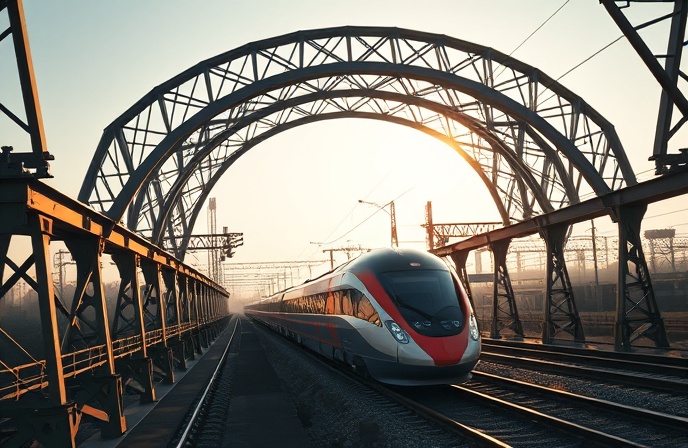Texas High-Speed Rail: Houston-Dallas Line Approved

The development of high-speed rail (HSR) in the United States has been a subject of ongoing debate and planning for many years. While various proposals have emerged across the country, significant hurdles – both political and logistical – have often stalled progress. This article will delve into the approval process and implications of a key HSR project: the proposed 240-kilometer line connecting Houston and Dallas, Texas. This project, spearheaded by Texas Central Railroad, a subsidiary of Texas Central, represents a potential paradigm shift in American rail travel, offering a faster and more efficient alternative to existing transportation methods. The granting of crucial approvals by the Federal Railroad Administration (FRA), including the final Rule of Particular Applicability (RPA) and the Record of Decision (ROD), marks a pivotal moment in the project’s development. We will examine these approvals, analyzing their significance and exploring the technological, regulatory, and economic factors influencing the project’s feasibility and future prospects. The discussion will highlight the challenges that still need to be overcome and speculate on the broader impact this project might have on the national HSR landscape.
Regulatory Approvals: A Milestone Achieved
The issuance of the final Rule of Particular Applicability (RPA) by the FRA is a critical step in the project’s regulatory pathway. The RPA establishes a comprehensive safety framework for the Texas Central Railroad, outlining detailed requirements for infrastructure design, operational procedures, and maintenance protocols. This detailed regulatory framework ensures the system’s safety and compliance with stringent federal standards. The RPA’s focus on safety is particularly important given the high speeds involved in HSR operations. The document addresses various safety-critical aspects, including track design, signaling systems, emergency response plans, and train control technology. The rigorous standards set forth in the RPA contribute to the project’s overall credibility and demonstrate the FRA’s commitment to ensuring a safe and efficient high-speed rail network.
Environmental Impact and Alignment Finalization
The Record of Decision (ROD) concludes a six-year environmental review process conducted by the FRA. This exhaustive review assessed the potential environmental impacts of the project, considering factors such as land use, wildlife habitats, and air and water quality. The ROD not only confirms the project’s environmental compatibility but also finalizes the chosen alignment for the high-speed rail line. This aspect is crucial as the alignment impacts land acquisition, construction logistics, and the overall project cost. The careful consideration given to environmental concerns showcases a commitment to sustainable development practices and responsible infrastructure planning, addressing possible public concerns regarding ecological impact.
Technological Foundation: The Shinkansen Model
The Texas Central project’s design draws inspiration from Japan’s renowned Tokaido Shinkansen high-speed rail system. This approach leverages proven technology and operational expertise to mitigate risks and enhance the likelihood of project success. Adopting a well-established model provides a blueprint for construction, operation, and maintenance, reducing uncertainties and accelerating the implementation process. The Shinkansen’s long history of safe and efficient operation offers reassurance to investors and the public, demonstrating the feasibility and reliability of the chosen technology. However, adapting this technology to the unique geographical and regulatory landscape of Texas will require careful engineering and planning.
Economic Implications and Future Prospects
The Houston-Dallas high-speed rail project has the potential to significantly impact the Texas economy. Beyond facilitating faster travel between two major metropolitan areas, it could stimulate regional economic growth by improving connectivity, supporting tourism, and potentially creating employment opportunities. The project’s success hinges not only on technical feasibility and regulatory compliance, but also on securing sufficient funding and overcoming potential political and logistical challenges. Successful completion would demonstrate the viability of high-speed rail in the US and could pave the way for the development of other similar projects across the nation.
Conclusions
The approval of the final Rule of Particular Applicability (RPA) and the Record of Decision (ROD) by the Federal Railroad Administration (FRA) represents a major milestone for the Texas Central Railroad’s high-speed rail project connecting Houston and Dallas. These approvals signify a comprehensive review and validation of the project’s safety standards and environmental compatibility. The adoption of the Japanese Shinkansen model provides a technologically sound foundation, leveraging proven technologies and operational expertise. The project’s potential economic impact is significant, promising improved connectivity, enhanced regional development, and potential job creation. While challenges remain, including securing financing and managing potential logistical hurdles, the project’s advancement signals a potential shift in the American HSR landscape. Successful completion of this project would not only deliver significant benefits to Texas but could also serve as a model for future high-speed rail initiatives across the United States, encouraging further investment and development in this vital mode of transportation. The regulatory approvals provide the framework for a safe and efficient system, paving the way for a future where high-speed rail is a viable and significant component of the nation’s transportation infrastructure. The meticulous environmental review process and the decision to emulate the successful Shinkansen system underscore a commitment to both environmental sustainability and technological excellence. Ultimately, the success of this project hinges on diligent execution, continued collaboration between stakeholders, and unwavering dedication to delivering a safe, efficient, and economically viable high-speed rail system for Texas and potentially for the rest of the country.




